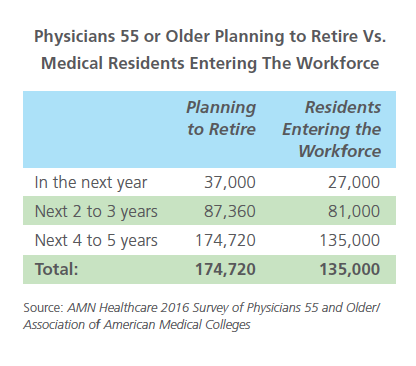We talk a lot about recruiting physicians, attracting new graduates and boosting company culture in order to build a stronger employer brand, but what is not often addressed is developing a succession plan. What will you do when your physicians start to retire?
Did you know that according to the AMN 2016 Survey of Physicians 55 and Older, “there are various medical specialties in which 50% or more of physicians are 55 years old or older, including orthopedic surgeons, cardiologists, neurologists, psychiatrists, oncologists and pulmonologists?” And, according to the American Association of Medical Colleges there is a “projected shortage of up to 90,400 physicians by the years 2025.”
The idea that 50% of the specialized physician workforce is approximately 10 years away from retirement should be considered a major concern for healthcare systems. So how should hospitals and clinics deal with the situation? Here’s a 3-step action plan you can take to ease the stress.
1. Survey Your 55+ Physicians
According to AMN, all the following items should be included:
- What is your projected retirement date? Please note that according to the AMN findings, “11% of physicians 55 or older (or approximately 37,000 physicians projected over the total population workforce) plan to retire within the next year.”
- Do they have a plan in place for when they leave? According to AMN’s research, “only 21% of physicians 55 or older have made plans to transfer their patients to another physician group when they retire, while only 23% are involved in a succession plan with their hospital or medical group.”
- How do they like their current position?
- Over time have they become more or less happy with the process of practicing medicine?
- What are their thoughts on training and boosting morale/work ethic in younger generations of doctors? AMN’s research found that, “81% of physicians 55 or older indicated that physicians coming out of training today are less hard working than physicians were in the past.” Clearly, a plan needs to be put in place to reconcile these differences.
2. Take Advantage of Locum Tenens Physicians
Locum tenens candidates are great resources because some of them work later into their career than full time staff physicians. In fact, according to AMN, “36% are 61 or older.” Establishing a relationship with locum tenens physicians (and possibly creating your own internal pools of these candidates) may lessen the drop-off factor when your physicians eventually start to retire. In fact, making existing physicians aware that you hire locum tenens may allow them to stay on with you in a limited capacity.
3. Access Happiness
One key finding to AMN’s research is that many physicians are less happy with their current medical practice situation as they were when they first started working in medicine. In fact, of those surveyed from ages 55 to 66 or older, 64% say that their professional satisfaction has decreased.
It’s very important that healthcare systems speak to their aging doctors about what would make them happier when it comes to their work life. This is going to be different for every person, but if you survey enough of your workforce, you’ll begin to notice trends and will be able to effect change.
Are your physicians happy? Are you unsure or overwhelmed? Why not try this free tool to get the conversation started?
--
The fact is, more physicians in the current workforce plan to retire in the next year than are entering as medical residents (chart below is from the AMN 2016 Survey of Physicians 55 and Older which we encourage you to look at in full here). This trend needs to be addressed so that hospitals aren’t crippled by an onset of physician recruitment needs.
Though it won’t solve all recruitment issues, a good place to start when it comes to recruiting new physician hires is reviewing your salaries. Check out our free tool below to find out if yours are industry-competitive.












